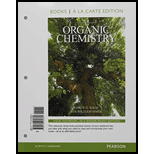
Organic Chemistry, Books a la Carte Edition (9th Edition)
9th Edition
ISBN: 9780134160382
Author: Leroy G. Wade, Jan W. Simek
Publisher: PEARSON
expand_more
expand_more
format_list_bulleted
Concept explainers
Question
Chapter 14.10B, Problem 14.19P
Interpretation Introduction
Interpretation:
The method of synthesis of
Concept introduction:
Silyl ethers are used as alcohol-protecting groups. A good protecting group should be easy to add and remove. An ether protecting group is difficult to deprotect. Strong acids are required to deprotect it. However, silyl ethers are easily removed as compared to carbon-based ethers. The silyl ether is stablised by three bulky isopropyl groups.
Expert Solution & Answer
Want to see the full answer?
Check out a sample textbook solution
Students have asked these similar questions
Draw the products formed when hex-1-yne is treated with each reagent.
Show arrow pushing as well.
[1] R2BH; [2] H2O2 , HO−
Draw the product of the given reaction sequence.
NaOCH 3,
CH₂OH
A
Draw the products formed in attached reaction.
Chapter 14 Solutions
Organic Chemistry, Books a la Carte Edition (9th Edition)
Ch. 14.2C - Rank the given solvents in decreasing order of...Ch. 14.2D - Prob. 14.2PCh. 14.2D - In the presence of 18-crown-6, potassium...Ch. 14.3B - Give a common name (when possible) and a...Ch. 14.3C - Prob. 14.5PCh. 14.3C - Name the following heterocyclic ethers.Ch. 14.4 - Propose a fragmentation to account for each...Ch. 14.5 - Prob. 14.8PCh. 14.5 - Prob. 14.9PCh. 14.6 - Prob. 14.10P
Ch. 14.7 - Explain why bimolecular condensation is a poor...Ch. 14.7 - Prob. 14.12PCh. 14.7 - Prob. 14.13PCh. 14.8 - Prob. 14.14PCh. 14.8 - Prob. 14.15PCh. 14.8 - Prob. 14.16PCh. 14.10A - Prob. 14.17PCh. 14.10A - Prob. 14.18PCh. 14.10B - Prob. 14.19PCh. 14.11B - Show how you would accomplish the following...Ch. 14.11B - Prob. 14.21PCh. 14.12 - Prob. 14.22PCh. 14.12 - Prob. 14.23PCh. 14.12 - Prob. 14.24PCh. 14.13 - Prob. 14.25PCh. 14.13 - Prob. 14.26PCh. 14.14 - Prob. 14.27PCh. 14.15 - Give the expected products of the following...Ch. 14 - Write structural formulas for the following...Ch. 14 - Give common names for the following compounds. a....Ch. 14 - Give IUPAC names for the following compounds. a....Ch. 14 - Glycerol (propane-1,2,3-triol) is a viscous syrup...Ch. 14 - Prob. 14.33SPCh. 14 - Show how you would make the following ethers,...Ch. 14 - (A true story.) An inexperienced graduate student...Ch. 14 - Prob. 14.36SPCh. 14 - a. Show how you would synthesize the pure (R)...Ch. 14 - a. Predict the values of m/z and the structures of...Ch. 14 - The following reaction resembles the...Ch. 14 - Prob. 14.40SPCh. 14 - Prob. 14.41SPCh. 14 - Prob. 14.42SPCh. 14 - Give the structures of the intermediates...Ch. 14 - Prob. 14.44SPCh. 14 - Show how you would synthesize the following ethers...Ch. 14 - Prob. 14.46SPCh. 14 - Prob. 14.47SPCh. 14 - Prob. 14.48SPCh. 14 - An acid-catalyzed reaction was carried out using...Ch. 14 - Propylene oxide is a chiral molecule. Hydrolysis...Ch. 14 - Prob. 14.51SPCh. 14 - Prob. 14.52SPCh. 14 - Prob. 14.53SPCh. 14 - Prob. 14.54SPCh. 14 - In 2012, a group led by Professor Masayuki Satake...
Knowledge Booster
Learn more about
Need a deep-dive on the concept behind this application? Look no further. Learn more about this topic, chemistry and related others by exploring similar questions and additional content below.Similar questions
- Draw the product for the following reaction.arrow_forwardDraw all possible products formed when 2-methylbut-2-ene undergoes addition with HCl. Label them as being either the major or the minor product.arrow_forwardDraw the products formed when hex-1-yne is treated with below reagent. [1] R2BH; [2] H2O2, HO−arrow_forward
- Draw the major product formed in attached reactionarrow_forward1. Identify (draw the structure) of the missing reactant, reagent, or major product required to complete the following transformations. If the product gives two enantiomers, you only need to give one. Cl2 H20 OH H2, Pd МСРВА 1.Hg(OAc H,O 2.NaBH, OHarrow_forwardDraw eugenol as a line structure. The double bonds of the benzene ring are fairly unreactive unless you use special catalysts. But the double bond on the side group is reactive. Draw the mechanism of eugenol reacting with HBr to form the two possible carbocation intermediates. Put your intermediates into square brackets. Label each carbocation as a methyl carbon or 1°, 2°, or 3°. Then circle a more stable carbocation if one is more stable. Can you guess what the final product is?arrow_forward
arrow_back_ios
SEE MORE QUESTIONS
arrow_forward_ios
Recommended textbooks for you
 Organic Chemistry: A Guided InquiryChemistryISBN:9780618974122Author:Andrei StraumanisPublisher:Cengage Learning
Organic Chemistry: A Guided InquiryChemistryISBN:9780618974122Author:Andrei StraumanisPublisher:Cengage Learning

Organic Chemistry: A Guided Inquiry
Chemistry
ISBN:9780618974122
Author:Andrei Straumanis
Publisher:Cengage Learning